home
> products
> BAT's
>
BAT
examples
> example A.1.a
Air-coupled surface profilometry by a reflection focussed BAT® transducer
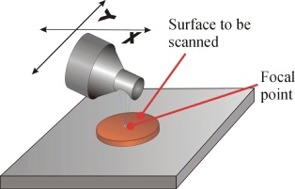
The experiment:
The reflection-focussed BAT-3 transducer is well-suited to imaging the surfaces of materials for the purposes of surface profiling and metrology. By aligning the focal point of the ultrasonic beam on a surface of interest, high resolution pulse-echo images can be obtained by mechanical scanning of the transducer or surface.
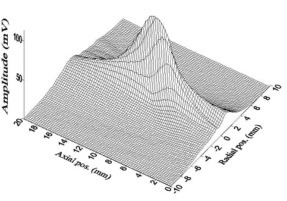
Because lateral resolution in such imaging
work increases with decreasing focal diameter, a tightly focussed
transducer field is required for successful surface imaging measurements.
The pulsed ultrasonic field of MicroAcoustic's
BAT-3 transducer (shown right)
is highly focussed, having a diffraction-limited spot-size of ~670µm at a
modest center frequency of ~500kHz. Such a tiny spot-size leads to a
lateral resolution of <200µm for surface imaging applications.
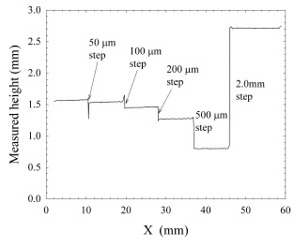
Imaging resolution is inherently much higher in the axial direction than it is in the lateral direction. This occurs because of the very low ultrasonic velocity in air (~345m/sec), which leads to large changes in time-of-flight even for small changes in pulse-echo distances. Add to this the narrow temporal pulsed response of the BAT-3 transducer, and the axial resolution is even further improved. The figure at right demonstrates the superb axial resolution that can be obtained by the BAT-3 transducer using simple time-of-flight measurements. In this figure, known step-heights (ranging from 50µm to 2mm) are accurately measured by the air-coupled imaging system by scanning the transducer focus across the steps. Note that step heights as small as 2µm have been reliably measured in this way.
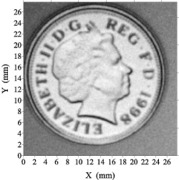
The overall resolution of an air-coupled imaging system allows surprisingly high definition images of material surfaces to be acquired. This can be seen in the "ultrasonic photograph" taken at right for the back-side of an English pound coin. This image was acquired by plotting the pulse-echo amplitude obtained by a MicroAcoustic BAT-3 transducer as a function of transducer position as it scanned over the coin's surface. Though not in competition with optical imaging techniques in terms of resolution, air-coupled ultrasonic surface imaging is entirely independent of the material properties of the sample and in particular has no requirement that the surface of the material be optically reflective, etc. This means that identical surface structures created upon a metallized mirror and opaque ceramic, for example, would yield identical images via air-coupled ultrasonic measurements.
Combined amplitude/time-of-flight imaging:
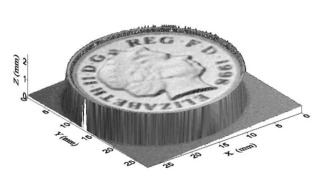 By
combining both amplitude and time-of-flight information from the returning
pulse-echo measurements, accurate depth information can further be added
to air-coupled surface images. This is demonstrated in the figure at right
where 3-dimensional surface relief of the English pound coin is now
accurately added to the "ultrasonic photograph" taken by MicroAcoustic's
BAT-3 transducer.
By
combining both amplitude and time-of-flight information from the returning
pulse-echo measurements, accurate depth information can further be added
to air-coupled surface images. This is demonstrated in the figure at right
where 3-dimensional surface relief of the English pound coin is now
accurately added to the "ultrasonic photograph" taken by MicroAcoustic's
BAT-3 transducer.
1) This example shows how suitably-focussed MicroAcoustic BAT® transducers provide an alternative non-contact technique for high-resolution imaging of the surfaces of materials.
2) Though an air-coupled ultrasonic surface imaging system cannot compete with its optical counterpart in terms of resolution, it does offer unique advantages over optical based systems, such as:
-
no sample illumination being required and so can operate equally well in complete darkness
-
often simpler to use and maintain, and typically less-expensive
-
no restrictions on sample surfaces i.e., samples can be optically opaque, transparent or reflective
-
a wide range of axial distances can be measured by a single system (i.e., from the micron level all the way up to centimeter levels and beyond)
<< previous example ~ next example >>
www.microacoustic.com